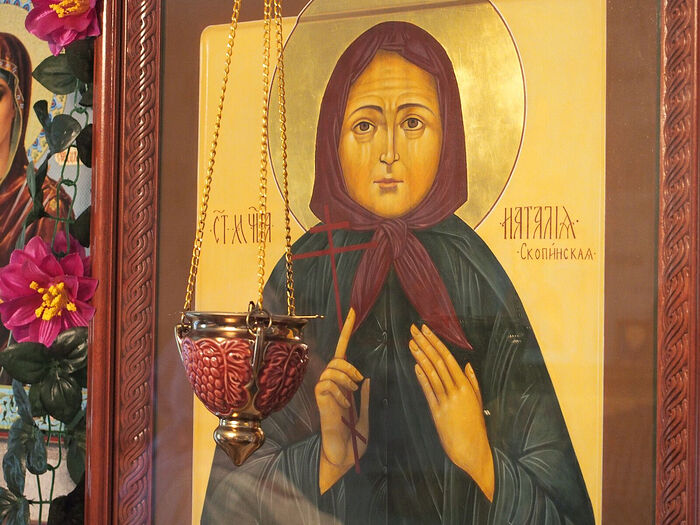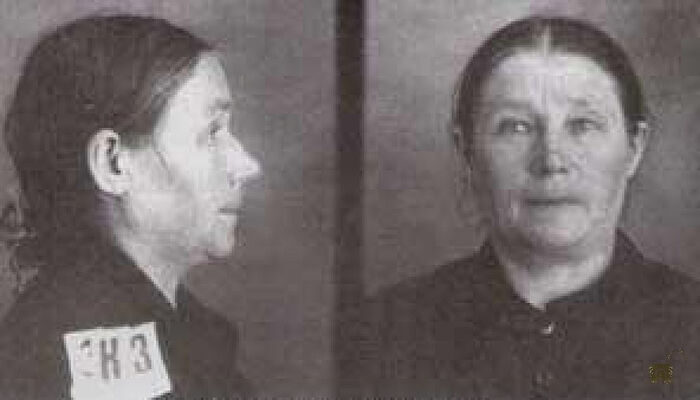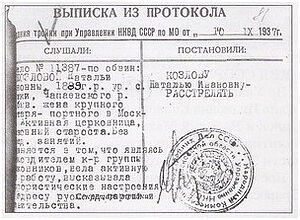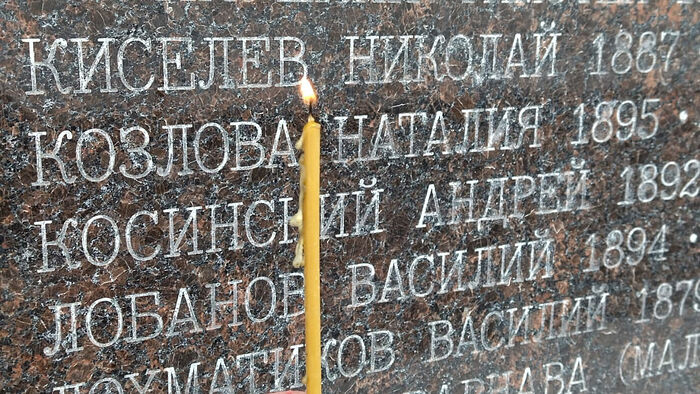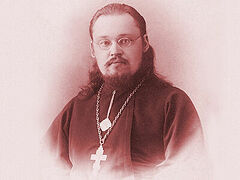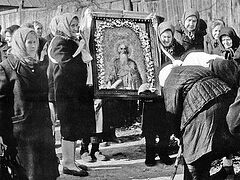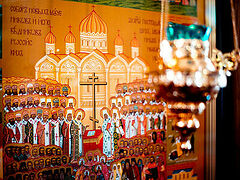Part 1: The Village of Churiki and its saint
The holy Martyr Natalia (Natalia Ivanovna Kozlova) was born on September 12, 1895, into a peasant family in the village of Churiki. There were five children in the family, and she was the youngest. Natalia successfully graduated from a three-year rural school, was literate and read the Holy Scriptures and spiritual literature with great interest. She tried not to miss a single church service. The piety of this peasant family is also confirmed by the fact that Matrona, one of the holy Martyr Natalia’s sisters, became a nun.
When Natalia came of age, she married her fellow villager Stepan Kozlov. The family lived by labor and prayers. Natalia worked in the church as a church warden. The Kozlov peasant family had a plot of land, livestock and everything necessary for agricultural work.
The memories of Natalia Ivanovna’s daughter, Maria Stepanovna Osina, allow us to get a clearer picture of the Kozlovs’ household:
“On their nine sotkas (0.09 hectare) the parents grew wheat, rye and oats. They kept a horse, a cow, sheep and chickens—it was a typical peasant farm. To provide for eight children the father, a jack-of-all-trades, would work as a glassmaker in Moscow during the winter. The older children studied there and helped their father. Our father and brothers built a house in Churiki with a galvanized roof and a spacious room. An icon lamp always burned by the icons In the holy corner...”
But the Kozlov family were not “rich kulaks” [wealthy peasants who had their own farms and hired labor. Many were subjected to Stalin’s forced collectivization or repressed.—Trans.]. And Natalia Ivanovna was not an illiterate, benighted woman. On the contrary, she was one of the few educated women in her village. It was a strong, good family, the likes of which formed the main composition, the strength of the Russian people.
As a literate person Natalia was first treasurer and then she was elected churchwarden. On June 26, 1935, for zealous service for the good of the Church, on the proposal of church rector Fr. Eugene Svetlov, she was awarded a certificate of recognition by Bishop Ignaty (Sadkovsky) of Skopin.
The Kozlov family was very religious, and during the persecution of the Church and domination by the Soviet government they stayed away from the Communist Party and the collective farm. The 1930s were tragic for our entire country. A tragedy befell the Kozlov family as well: Natalia lost her husband, and their horse was confiscated.
Stepan Vasilyevich came out in defense of the church and spoke out against collective farms. For this he was killed on the way to the district center. Natalia Ivanovna was left alone with four small children on her hands. People rebuked her for such zeal, and the neighbors asked her, “What will happen to the little ones if you are arrested?” “It’s all in God’s hands,” Natalia answered. “And what about us?” her daughter Maria asked plaintively. “The Lord will not abandon you,” her mother answered affectionately and with faith. A mother of eight children, widowed as a result of the tyranny of the authorities who had murdered her husband without trial or investigation, was not afraid to take an active position in the defense of the Orthodox Church.
She was destined to become the last churchwarden, guardian and defender of the Theophany Church in the village of Churiki in the Ryazan region—a difficult role even for a man. But her husband was dead, and the priest and the ruling bishop had been arrested. Natalia herself plowed the field and gathered people in the village to demand permission to serve in the church, which had been turned into a granary. The authorities were surprised: how could a simple woman have organizational talents, and where did she get such inner strength to come to Moscow and get to Kalinin’s1 office?!
Someone else could have been broken or become bitter. But Natalia became the churchwarden of the large Theophany Church in the middle of the village, and in May 1937, at the initiative of the Church Council of the Theophany Church, she arranged a large meeting of the faithful of the parish of Churiki—1200 households! Natalia inspired her fellow villagers to march in a peaceful procession in defense of the church, collecting even more signatures against its closure. Half of the church had already been converted into a granary.
In June, Natalia Ivanovna together with a member of the Church Council, Vasily Matveyevich Abramkin, and a group of activists travelled to Kalinin’s office in Moscow, where they handed over to him 400 signatures of their fellow villagers demanding that the confiscated half of the church be returned to the faithful. Natalia was not afraid to keep in touch with the future Hieromartyr Ignaty (Sadkovsky), Bishop of Skopin, who was in prison. She sent parcels and letters to priests and church workers arrested on fabricated false denunciations. Everyone knew about her role in defending the church, and her arrest was not long in coming.
Arrest and execution
The “godless five-year plan” was gaining momentum. It was decided to demolish the church in Churiki. Before implementing their plan, the authorities decided to do away with the church’s defenders. The resolution of the Directorate of the People’s Commissariat of Internal Affairs (UNKVD) for the Moscow region of August 14, 1937, read:
“Kozlova Natalia Ivanovna, born 1895 and coming from the village of Churiki <...>, is an active smallholder and a church-goer. Being hostile to the Soviet regime, she conducts active anti-Soviet agitation among collective farmers aimed at the collapse of collective farms, conducts religious propaganda among the population, expresses defeatist sentiments and makes terrorist statements against the Communist Party leaders and members of the Soviet government. In the autumn of 1936, she organized a counter-revolutionary procession of church people, 150 in number, who threatened the village Communists and activists with reprisals for the arrest of Priest Svetlov... Take Kozlova Natalia Ivanovna as accused under Article 58, paragraph 10 of the Criminal Code; detention in Skopin Prison shall be chosen as a measure of restraint.”
From the memoirs of Natalia Kozlova’s daughter:
“Two nighttime strangers turned everything upside down in the house, looking for religious literature and letters. They shoveled everything into a bag and dragged it into the police van.”
On the sly Natalia slipped an old thick book to her daughter: “Keep the Bible, Maria!” The desecrators couldn’t have imagined that it would someday become an exhibit in the museum of the Butovo firing range.
On August 16, 1937, Natalia Ivanovna and two other members of the Church Council of the Theophany Church—Vasily Matveyevich Abramkin and Vasily Danilovich Orlov—were put in the Moscow Taganka Prison. On September 10, by a decision of the Troika of the UNKVD of the USSR for the Moscow region, they were sentenced to death.
On September 14, 1937, all three were shot at the Butovo firing range. Two days before the execution Natalia Kozlova had turned forty-two. Her youngest child was about a year and a half at the time. Thus did the Soviet Government put an end to several more “enemies of the people”.
This was the testament that Natalia left behind for her children: trust in God and the Holy Scriptures. And God did not abandon her children; they lived together, taking care of each other. None of them ended up in an orphanage, and after the war they moved to Vilnius. And the children carefully preserved Natalia Ivanovna’s Bible and shawl and donated them to the memorial museum at the church in Butovo.
The Butovo firing range
The Butovo firing range is a place of pain and sorrow. Every year on October 30, the remembrance day of the victims of political repression, people come here and read the names of those who were shot and buried here. These people were not killed in the war, but by the sentences of the authorities of their country on fake charges. In less than two years—in 1937 and 1938—over 20,000 people were executed at the secret firing range in Butovo.
On the granite slabs of the alley, which is about 1000 feet long, there are 20,762 names of people who were shot at the firing range between August 1937 and October 1938. The name of Natalia Ivanovna Kozlova is also immortalized on the plaque of the “Garden of Memory” memorial complex. On the lower level of the large Butovo church there is a small museum, which contains the New Martyrs’ personal belongings, photographs, and relics. In one of the showcases there are an icon, a diocesan certificate of recognition, a simple paper icon and the shawl that belonged to St. Natalia Kozlova in her lifetime. From the icon hanging nearby an elderly woman in a village headscarf looks at us—St. Natalia of Skopin. Two of her photographs are located in the same window: on the first a woman in a headscarf with kind eyes is the embodiment of gentleness and motherhood; on the second, after her arrest, her features are sharper, and her gaze is more fixed. All these things were donated to the museum by the saint’s children. One of her sons wrote years later:
“In those distant, monstrously tragic years, our mother Natalia Ivanovna Kozlova suffered. She was a mother of eight children, in whose upbringing she had invested her loving heart and kind, sincere soul. With great gratitude we cherish her maternal love, care and affection...”
From the day of the first meeting at the parish of the Church of the Theophany in Churiki a strong friendship developed with the rector of the Church of the Holy New Martyrs and Confessors of Russia in Butovo, Archpriest Kirill Kaleda and his assistants. Since then not a single memorable service in the Theophany Church has been complete without a delegation from Butovo.
In 1989, Natalia Ivanovna Kozlova, Vasily Matveyevich Abramkin and Vasily Danilovich Orlov were rehabilitated by the Prosecutor’s Office of the Ryazan region, “owing to the absence of corpus delicti in their actions.” For many years her children had not known anything about Natalia’s fate. Her youngest son Alexander wrote to all the authorities, but in vain.
After many years, they finally responded to Alexander Stepanovich’s inquiries, and in 1992 he was invited to the KGB (State Security Police) on Lukishskaya Square of Vilnius. They showed him a folder with a frontal and a profile photo of his mother, along with a letter from Bishop Ignaty of Skopin and allowed him to take it with him. On its back the following was scribbled with a blue pencil by Natalia’s hand: “Found in my house during a search. Kozlova, 16.8.37.” But the children did not manage to get answers to their questions about their mother’s fate and the location of her grave until the laws were passed on the restoration of the rights of the repressed. It was not until the 1990s that her relatives found out that she had been shot at the Butovo firing range on the Church New Year—September 1/14, 1937. And by the decision of the Holy Synod of the Russian Orthodox Church of August 17, 2004, the name of the churchwarden of the Theophany Church of the village of Churiki Natalia Ivanovna Kozlova was added to the Synaxis of the New Martyrs and Confessors of Russia.
Exactly eighty years passed, and by the grace of God St. Natalia returned to her church in the form of her icon! The icon was painted in 2017 by the icon-painter Tatiana Kotova especially for the church.
And now the troparion to her is sung in the Church of the Theophany:
“Tireless worker in the vineyard of Christ, thou didst keep to the end a faith beyond reproach, love for the Lord and thy neighbor with hope in the God Most High; for Him thou didst suffer even to the shedding of your blood, O holy Martyr Natalia, pray to Christ our God to grant us great mercy and save our souls.”
In our times, the labor of such saints as Natalia of Skopin strikes us to the core. In life she was an ordinary, unremarkable person, a simple village woman, a widow with many children...
To be continued…

